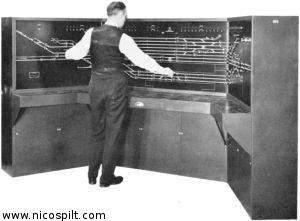Routes

A route is a definition of how to travel from one block to another block.
A train can travel from block A to block B. If it is also desired to go from block B to block A, this must be indicated separately in the properties. A complex route my have Crossing Blocks. (The example below does not need a Crossing Block entry.)
Through the use of Routes a train can move from one block to another. If a Route is allocated, the positions of switches and crossings are set to allow the train to go from one block to another. If within a Route a crossing exists, whose position can not be changed, this crossing must be included in the plan in order to avoid accidents. Thus, although a crossing does not have an address, it must be defined as an active element, so that the crossing can be released in the active route.
Example:
Turnout w1 is a normal switch, the crossing w2 is not adjustable (no slip switch). Consequently, a drive b3 to b5 or b2 to b4 is not possible. Let us imagine that in blocks b2 and b3 a train leaves, then there is a risk that at the intersection by w2 the trains could crash at the junction. Therefore, it is important to include passive crossings and switches that can be "cut" in the driveway, so they can be blocked for other trains, as long as a train passes through this route.
The routes that are possible in this example:
| From block | To block | Switch setting w1 | Switch setting w2 |
|---|---|---|---|
| b1 | b2 | thrown | - |
| b1 | b3 | straight | - |
| b2 | b5 | - | straight |
| b3 | b4 | - | straight |


